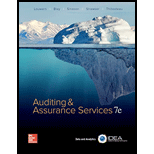
Compute the sample rate of deviation, ULRD, and allowance for sampling risk for each condition and write the comments for the relationship of each factor to the ULRD.
Explanation of Solution
Attributes sampling: Attributes sampling helps the auditor to assess a specific rate of occurrence for a specific characteristic of the audit population. It is helpful in finding the estimate related to a particular transaction or activity in the system.
Sample rate of deviation: It is a rate of deviation that ascertains the percentage of occurrence and accuracy of control. Sample rate of deviation is calculated by using the following formula:
Upper Limit Rate of Deviation (ULRD): It is an adjusted deviation rate that ascertains a conservative measure of the population rate of deviation and allows the auditor to control the disclosure of sampling risk to acceptable levels.
Allowance for sampling risk: It is the “adjustment” of the sample deviation rate for the acceptable risk of overreliance. Allowance for sampling risk is calculated by using the following formula:
a. Compute the sample rate of deviation, ULRD, and allowance for sampling risk:
- 1. Compute the sample rate of deviation:
- 2. Ascertain the ULRD by using AICPA sample evaluation tables:
According to the AICPA sample evaluation tables, the ULRD for 4 deviations of 60
- 3. Ascertain the allowance for sampling risk:
Hence, the sample rate of deviation, upper limit rate of deviation and allowance for sampling risk is 8%, 14.7% and 8% respectively.
b. Compute the sample rate of deviation, ULRD, and allowance for sampling risk:
- 1. Ascertain the sample rate of deviation:
- 2. Ascertain the ULRD by using AICPA sample evaluation tables:
According to the AICPA sample evaluation tables, the ULRD for 6 deviations of 60 sample size at 5% risk of overreliance is 18.8%.
- 3. Ascertain the allowance for sampling risk:
Hence, the sample rate of deviation, upper limit rate of deviation and allowance for sampling risk is 10%, 18.8% and 8.8% respectively.
c. Compute the sample rate of deviation, ULRD, and allowance for sampling risk:
- 1. Ascertain the sample rate of deviation:
- 2. Ascertain the ULRD by using AICPA sample evaluation tables:
According to the AICPA sample evaluation tables, the ULRD for 6 deviations of 60 sample size at 10% risk of overreliance is 16.9%.
- 3. Ascertain the allowance for sampling risk:
Hence, the sample rate of deviation, upper limit rate of deviation and allowance for sampling risk is 10%, 16.9% and 6.9% respectively.
Write the comments for the relationship of each factor to the ULRD:
The difference of ULRD in (a) and (b) is due to increase in number of deviation from 4 (in a) to 6 (in b). Here, the increase in ULRD from 14.7% to 18.8% indicates that the number of deviations and sample rate of deviation is directly proportional to ULRD.
The difference of ULRD in (b) and (c) is due to increase in the risk of overreliance from 5% (in b) to 10% (in c). Here, the decrease in ULRD from 18.8% to 16.9% indicates that the risk of overreliance is inversely proportional to ULRD.
Want to see more full solutions like this?
Chapter F Solutions
Auditing & Assurance Services (Auditing and Assurance Services)
- Below is information for Blue Company. Using this information, answer the following questions on the "Calculation" tab in the file. Show your work (how you got your answer) and format appropriately. Blue company has prepared the following contribution format income statement based on a sales volume of 1,000 units (the relevant range of production is 500 to 1,500 units): Sales $ 40,000 Variable expenses 24,000 Contribution margin 16,000 NOTE: Use the amounts in the original fact pattern to the left as your basis for the questions below. Fixed expenses 12,000 Net operating income $ 4,000 Questions: 1. What is the contribution margin per unit? 2. What is the contribution margin ratio? 3. What is…arrow_forwardI am looking for help with this financial accounting question using proper accounting standards.arrow_forwardGeneral accountingarrow_forward
- Please explain the correct approach for solving this general accounting question.arrow_forwardRobin Corporation has ordinary income from operations of $30,000, net long-term capital gain of $10,000, and net short-term capital loss of $15,000. What is the taxable income for 2010? a) $25,000. b) $27,000. c) $28,500. d) $30,000. e) None of the above.arrow_forwardPlease explain the solution to this financial accounting problem using the correct financial principles.arrow_forward

 AccountingAccountingISBN:9781337272094Author:WARREN, Carl S., Reeve, James M., Duchac, Jonathan E.Publisher:Cengage Learning,
AccountingAccountingISBN:9781337272094Author:WARREN, Carl S., Reeve, James M., Duchac, Jonathan E.Publisher:Cengage Learning, Accounting Information SystemsAccountingISBN:9781337619202Author:Hall, James A.Publisher:Cengage Learning,
Accounting Information SystemsAccountingISBN:9781337619202Author:Hall, James A.Publisher:Cengage Learning, Horngren's Cost Accounting: A Managerial Emphasis...AccountingISBN:9780134475585Author:Srikant M. Datar, Madhav V. RajanPublisher:PEARSON
Horngren's Cost Accounting: A Managerial Emphasis...AccountingISBN:9780134475585Author:Srikant M. Datar, Madhav V. RajanPublisher:PEARSON Intermediate AccountingAccountingISBN:9781259722660Author:J. David Spiceland, Mark W. Nelson, Wayne M ThomasPublisher:McGraw-Hill Education
Intermediate AccountingAccountingISBN:9781259722660Author:J. David Spiceland, Mark W. Nelson, Wayne M ThomasPublisher:McGraw-Hill Education Financial and Managerial AccountingAccountingISBN:9781259726705Author:John J Wild, Ken W. Shaw, Barbara Chiappetta Fundamental Accounting PrinciplesPublisher:McGraw-Hill Education
Financial and Managerial AccountingAccountingISBN:9781259726705Author:John J Wild, Ken W. Shaw, Barbara Chiappetta Fundamental Accounting PrinciplesPublisher:McGraw-Hill Education





